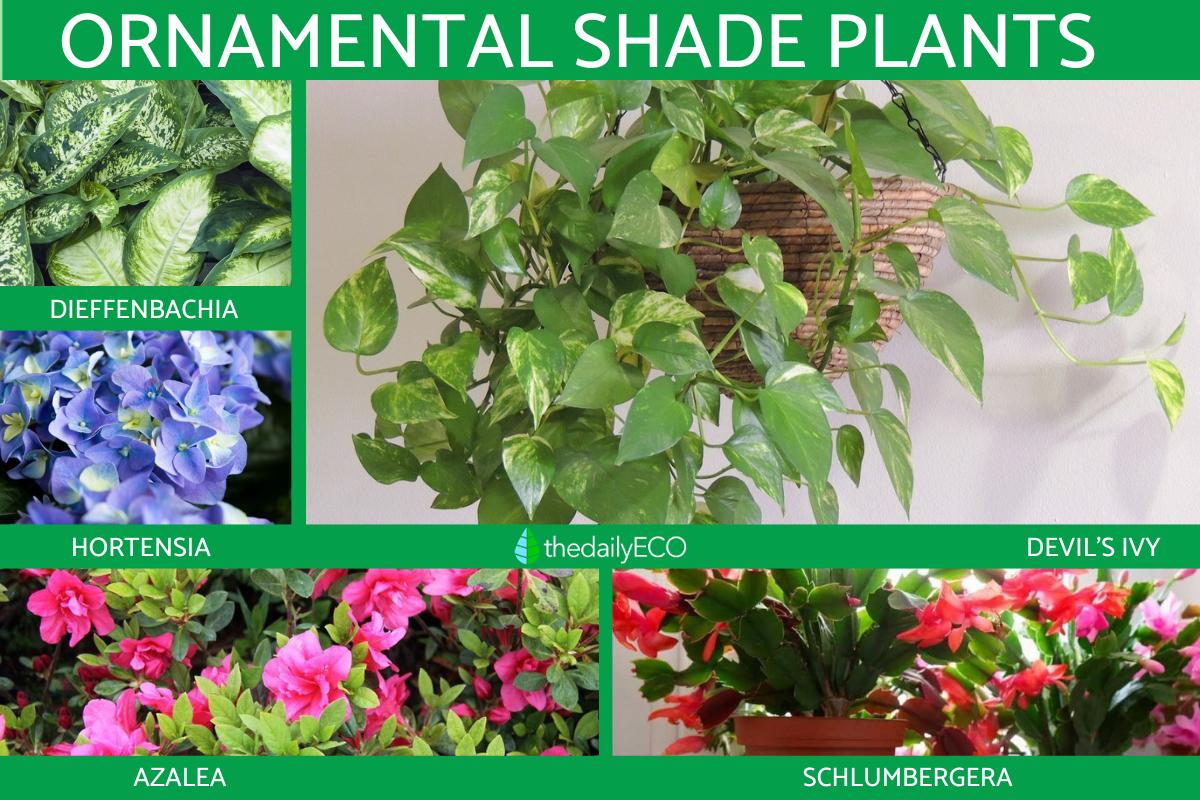Ornamental Plants - What They Are and Their Importance

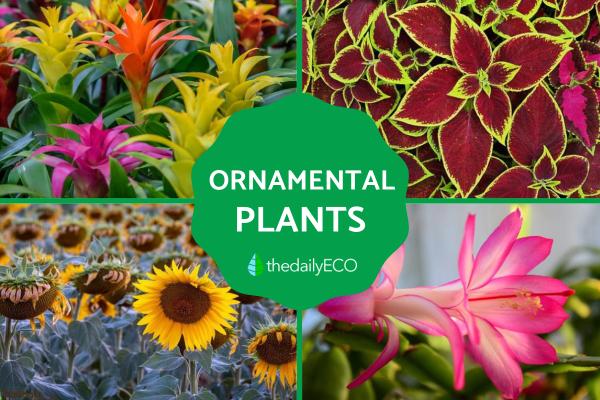
Ornamental or garden plants are plants that are grown primarily for their beauty, but also for their properties such as fragrance or interior decoration. Ornamental plants and garden varieties are usually specially bred varieties that improve on the original species in terms of color, shape, fragrance, and flower life. There are more than 3000 plants that can be considered as ornamentals. They can be grown outdoors in nurseries or greenhouses and used both indoors and outdoors.
In the following thedailyECO article, you will learn everything you need to know about ornamental plants, as well as what are the most popular species for indoor and outdoor use.
What are ornamental plants?
Ornamental plants are not a specific species or family within the plant genus. These plants are used to beautify or enhance a room or place by giving it an esthetic appeal. In other words, they are a decorative element. Ornamental plants can add height, privacy, and beauty to any garden. Furthermore, ornamental plants are very versatile and low maintenance.
The cultivation of ornamental plants in gardens began in ancient civilizations around 2000 BC. Historically, the Persians were the first to use plants in this way, and there is evidence that they decorated their palaces and buildings with plants, both indoors and in elaborate gardens. But ancient Egyptian tomb paintings from around 1500 BC also show physical evidence of ornamental planting and landscaping.
Ornamental plants are not only a feast for the eyes, but can also bring other benefits to your garden or home. Many of them have the ability to improve the quality of the air we breathe by filtering out unwanted substances. Others provide a pleasant aroma with their flowers and leaves.
In addition, many flowers in gardens and terraces attract beneficial pollinator insects.
Almost any types of plant have ornamental varieties: trees, shrubs, climbers, grasses, succulents, aquatic plants, herbaceous perennials and annual plants. Let us take a closer look at all the types of ornamental plants that exist.

Types of ornamental plants
Since this is neither a plant family nor a scientific classification, there are many ways to group ornamental plants according to their characteristics. We have developed a simple classification based on the most differentiated species. Thus, we find the following groups of ornamental plants:
Trees and shrubs
Its size and esthetic effect on gardens and natural areas make it one of the most popular ornamental plants. Deciduous flowering ornamental trees add a touch of color in spring and gorgeous foliage in summer and fall.
Lawns and ground cover
Grasses are plants in the Poaceae family that, when they grow, form a dense cover that completely covers the ground. They are often used to homogenize the landscape and give it a more natural feel. Ground covers can also be used instead. These are climbing plants that perform the same function but have different aspects and characteristics.
Annuals
In horticulture, plants that grow outdoors in spring and summer and survive only one growing season are called annuals. Ornamental annuals are called bedding plants and are often used in gardens to add colorful accents because they usually have a longer blooming period than perennials.
Bulbous
Bulbous plants are herbaceous and perennial plants that have underground nutrient storage organs such as bulbs, tubers, rhizomes, tubers, and tuberous roots. These species usually lose their above-ground portion during unfavorable growing seasons such as winter or summer and go dormant thanks to the reserves stored in their bulbs. When seasonal conditions become more favorable again, these reserves support the new growth cycle.
Palms
Palm trees come in all sorts of sizes and shapes, but they stand out for being very low-maintenance tropical plants that add an exotic touch to both indoor and outdoor spaces.
Ferns
Ferns are very primitive flowerless plants, but that is precisely why they are exotic. They are characterized by their dense and luxuriant foliage, which makes some of their species very suitable as hanging plants.
Climbers
Climbing plants are plants with the ability to grow supported or on surfaces of all kinds such as walls, facades, trees, or structures such as pergolas. Climbing plants in the garden are the perfect resource to fill the garden with color, beauty, and in many cases, atmospheric fragrances. They are perfect for decorating a pergola or a wall, and most of them are easy to grow.
Aquatic plants
Aquatic plants or water plants fill every corner of the garden pond with life. Aquatic plants, also known as hydrophytes or hygrophytes or macrophytes, are species adapted to wet environments such as lakes, ponds, marshes and swamps. Even if you do not have a large pond, you can grow aquatic plants. They can easily be planted in a watertight container filled with water.

Types of ornamental indoor plants
Below is a list of some of the most popular and easy to care for ornamental indoor plants:
- Striped dracaena (Dracaena fragrans)
- Dragon tree (Dracaena reflexa var. angustifolia)
- Umbrella papyrus (Cyperus alternifolius)
- Bromelia (Bromeliaceae)
- Dieffenbachia (Dieffenbachia ssp.)
- Prayer plant (Maranta leuconeura)
- Cyclamen (Cyclamen)
You may also be interested in this other article, where we talk about what are the best aromatic indoor plants.
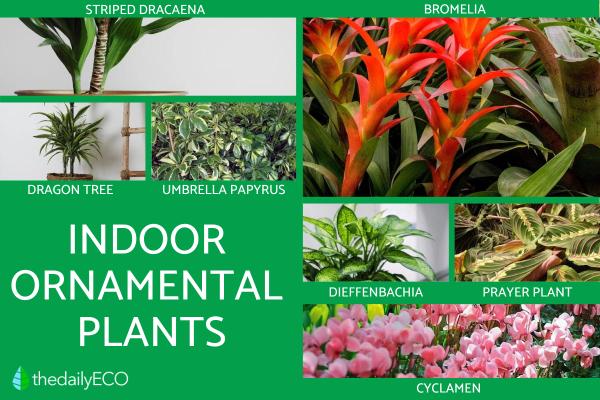
Types of ornamental outdoor plants
Now we present common outdoor ornamental plants, so you can add a touch of color and beauty to your garden. These are not only beautiful, but also easy to care for. Some popular examples include:
- Fern (Filicopsida)
- Carnation (Dianthus cayophyllus)
- Rose (Rosa spp.)
- Begoniaceae (Begoniaceae)
- Japanese maple (Acer palmatum)
- Arum-lily (Zantedeschia aethiopica)
- Garden petunia (Petunia hybrida)
- Coleus (Coleus blumei)
Types of ornamental sun plants
Although most plants appreciate getting as much sun as possible, not all of them can tolerate a large amount of direct light, especially in hot climates or when the sun is very intense. That is why we bring some popular ornamental plants that are known for tolerating high temperatures and direct sun:
- Bamboo (Bambusoideae)
- Echeveria (Echeveria)
- Transvaal daisy (Gerbera)
- Aster (Aster)
- Dahlia (Dahlia)
- Common Hibiscus (Hibiscus syriacus)
- Sweet violet (Viola odorata)
Types of ornamental shade plants
On the other hand, if you have little natural light or some shade in your garden, you may want to choose one of these other shady or semi-shady ornamental plant species:
- Dieffenbachia seguine (Dieffenbachia maculata)
- Hortensia (Hydrangea)
- Devil's ivy (Pothos)
- Rhododendron (Rhododendron)
- Schlumbergera (Schlumbergera)
Also, below are pictures of outdoor ornamental plants, in the order they were mentioned.
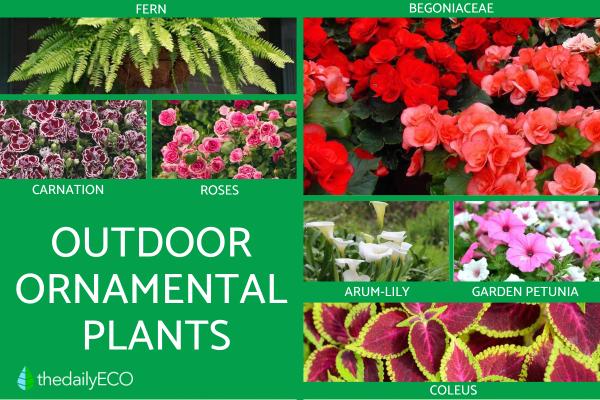
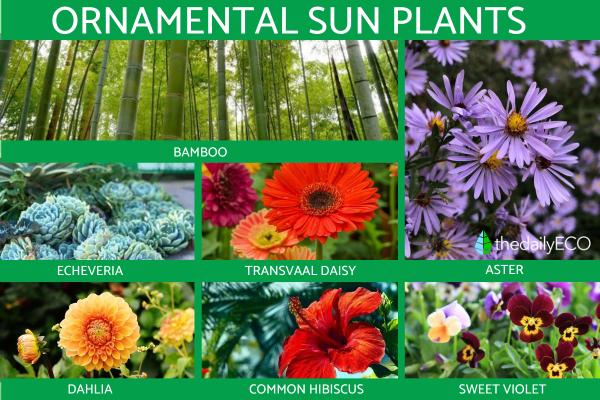
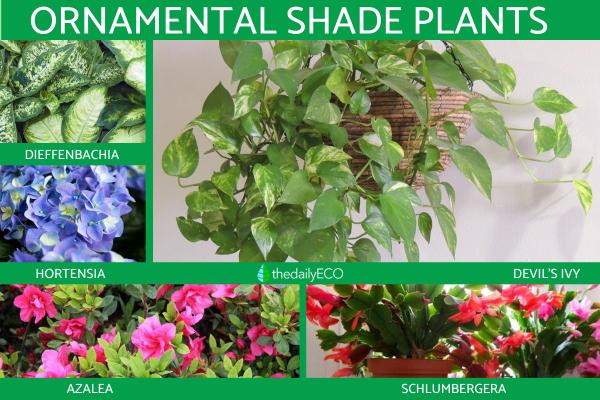
Importance of ornamental plants
Having learned about all these types of ornamental plants, we proceed to discuss their value. Both indoor and outdoor ornamental plants, including those used in gardens and on patios, as well as in parks and on walkways, have a wide range of benefits for us, other animals, and the environment.
These are the main benefits of ornamental plants, both in our houses and in public spaces:
- They provide landscaping that makes the environment more attractive and enriches spaces.
- They improve concentration and help relieve stress.
- They increase happiness and well-being by facilitating contact with nature.
- Some of these plants are also food and natural remedies.
- Planted directly on the ground, they prevent erosion.
- Plants bring energy and vitality and although it may seem unbelievable, it has been proven that living among plants changes your mood.
- These plants are a great natural filter as they clean the environment through the process of photosynthesis. Some of them are able to significantly reduce various toxins in the air, such as formaldehyde, benzene, or xylene.
- Both indoor and outdoor plants are sound absorbers.
- Caring for a plant has a therapeutic effect, which helps, among other things, to combat stress and anxiety.
- Aquatic plants in ponds or natural pools are not only decorative, but also purify the water to keep it crystal clear.
You may also be interested in this other article where we talk about what plants absorb moisture.
If you want to read similar articles to Ornamental Plants - What They Are and Their Importance, we recommend you visit our Decorative plants category.











